Professor Mladen Vranić received the honorary degree of the University of Zagreb, Croatia in 2011
http://www.croatia.org/crown/articles/10209/1/Professor-Mladen-Vraniae-received-the-honorary-degree-of-the-University-of-Zagreb-Croatia-in-2011.html
By Prof.Dr. Darko Zubrinic
Published on 12/17/2011
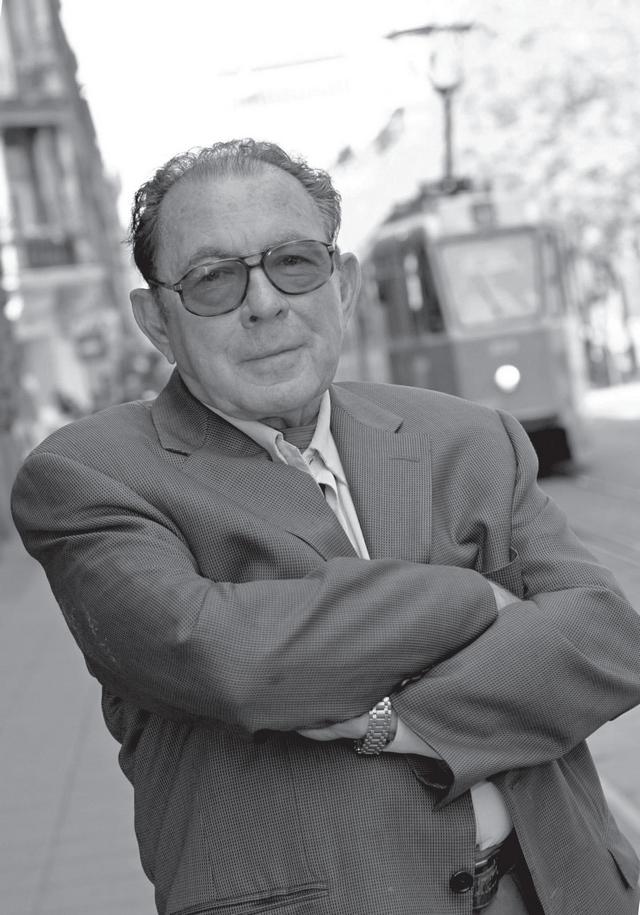
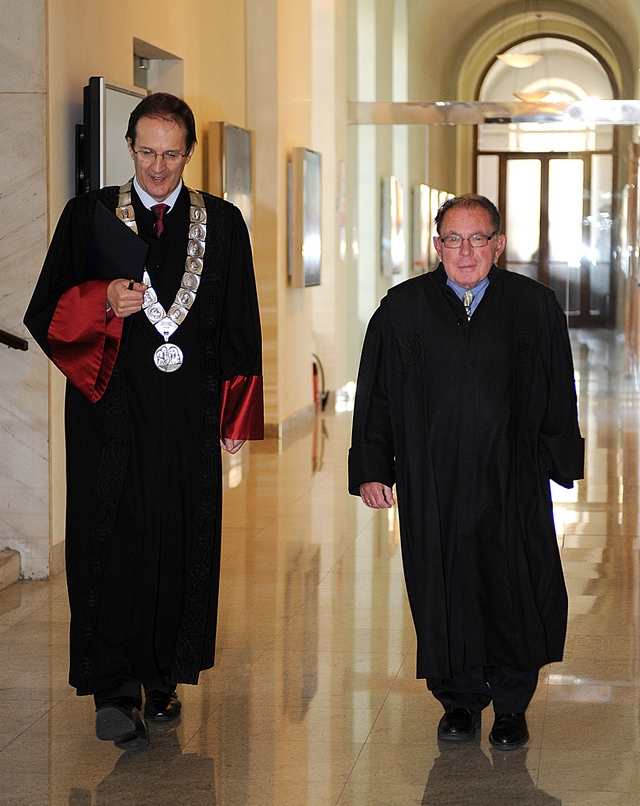
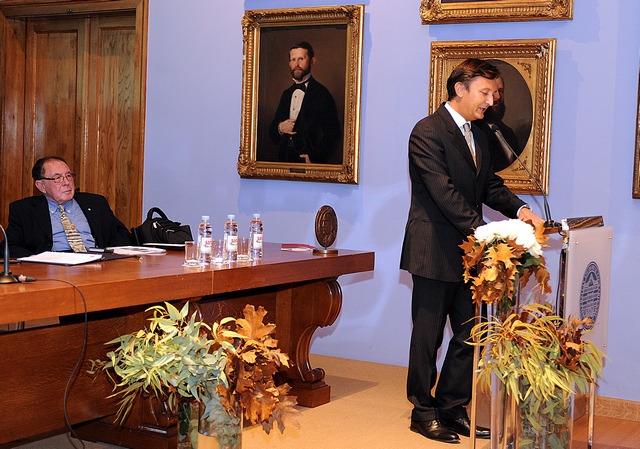
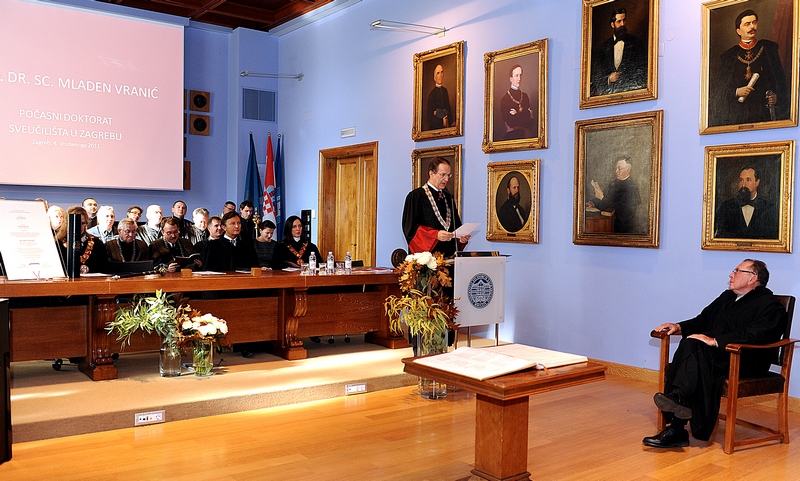


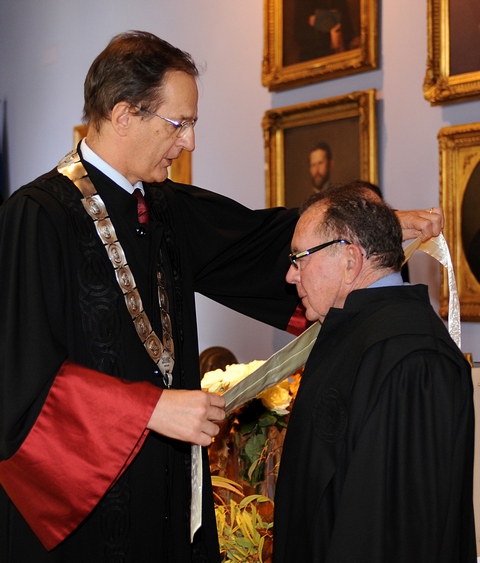
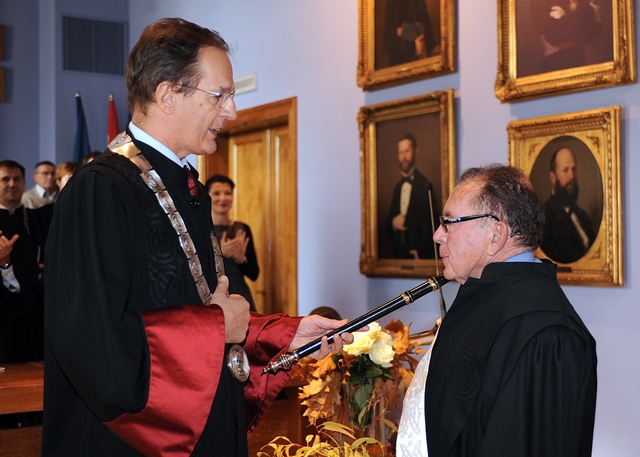

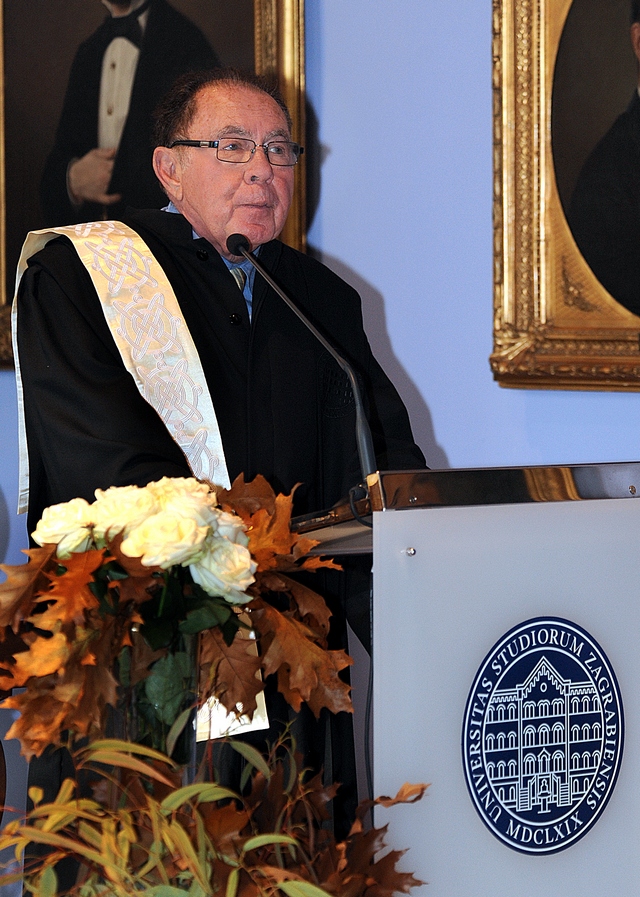

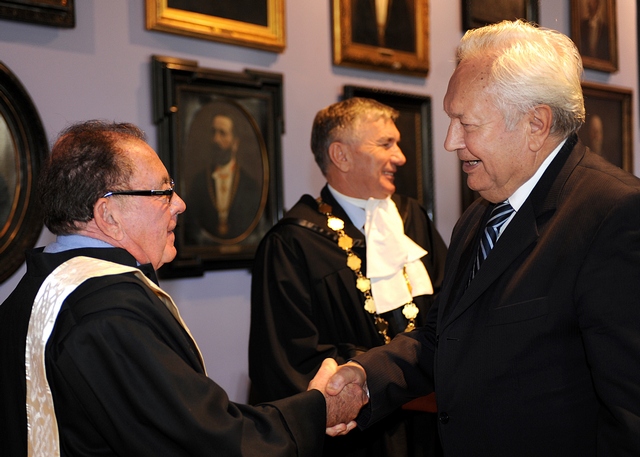
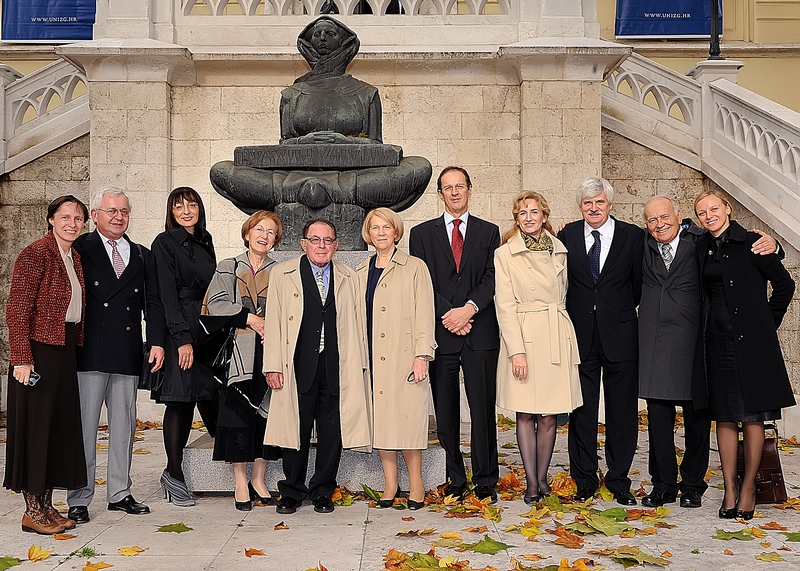
 | Mladen Vranić, professor emeritus of the University of Toronto, one of the leading experts in the field of diabetes prevention in the world, received the honorary degree from the University of Zagreb 4th November 2011. It is interesting that he defended his PhD at the same University in 1962. The doctor honoris causa degree was conferred to him by professor Aleksa Bjeliš, recotor of the University of Zagreb, in the presence of all the deans of the University, former rectors, etc. Professor Vranić has Croatian and Canadian citizenship, and is a member of the Royal Society of Canada and of Croatian Academy of Sciences and Arts. |
Distinguished expert in diabetes research

Professor Mladen Vranić in Zagreb
| Mladen Vranić, professor emeritus of the University of Toronto, one of the leading experts in the field of diabetes prevention in the world, received the honorary degree from the University of Zagreb 4th November 2011. It is interesting that he defended his PhD at the same University in 1962. The doctor honoris causa degree was conferred to him by professor Aleksa Bjeliš, recotor of the University of Zagreb, in the presence of all the deans of the University, former rectors, etc. Professor Vranić has Croatian and Canadian citizenship, and is a member of the Royal Society of Canada and of Croatian Academy of Sciences and Arts. |

Professor Aleksa Bjeliš, rector of the University of Zagreb, and professor Mladen Vranić, 4th November 2011

| Program Georg Friedrich Händel: Canticorum Iubilo uvodno slovo: Prof. dr. sc. Aleksa Bjeliš, rektor Sveučilišta u Zagrebu govor promotora: Prof. dr. sc. Željko Metelko Giuseppe Verdi: Quale piu fido amico, arija Carla iz opere Giovanna d’Arco proglašenje počasnim doktorom i uručenje diplome Vincenzo Bellini: Il fervido desiderio zahvala: Prof. dr. sc. Mladen Vranić Gaudeamus igitur Glazbeni program: Bože Jurić-Pešić, tenor, student 2. godine pjevanja Muzičke akademije Sveučilišta u Zagrebu Glasovirska pratnja: Davor Ljubić, umjetnički suradnik Mentorica: izv. prof. Vlatka Oršanić |

Uvodno slovo rektora Poštovani profesore Mladene Vraniću, Čast mi je i zadovoljstvo najsrdačnije Vas pozdraviti na početku ove svečane sjednice Senata, u ime Sveučilišta u Zagrebu i svoje. Osjećam se počašćenim što ću danas, zajedno s drugim kolegama, članovima Senata i drugim cijenjenim uzvanicima, moći predstaviti dostignuća koja Vas svrstavaju među vodeća imena moderne medicine u svijetu i jednako tako podsjetiti na Vašu neprekinutu privrženost Sveučilištu u Zagrebu, Vašoj Alma Mater. Uvažene ekscelencije i uzvanici, poštovane gospođe i gospodo, kolegice i kolege! Okupili smo se danas kako bismo proveli odluku donesenu na 1. sjednici Senata, u tekućoj 343. akademskoj godini, održanoj 11. listopada 2011., i promovirali profesora Mladena Vranića u počasnoga doktora Sveučilišta u Zagrebu. Profesor Željko Metelko uskoro će u ime Stručnoga povjerenstva za ocjenu prijedloga za dodjelu počasnoga doktorata izložiti pojedinosti o akademskim i znanstvenim dostignućima nekadašnjega studenta, a potom i mladoga asistenta našega Sveučilišta, koji je svoje prve uspješne istraživačke rezultate, uključujući i doktorat znanosti, ostvario ovdje u Zagrebu. Jednako tako, profesor Vranić je tijekom svoga dugogodišnjeg istraživačkog i edukativnog djelovanja, kao redoviti profesor fiziologije i interne medicine na Sveučilištu u Torontu te kao pozvani profesor i gost istraživač na nizu drugih svjetski renomiranih sveučilišta i istraživačkih centara, cijelo vrijeme zadržao blisku povezanost sa svojom Alma Mater, bilo kao istaknuti i angažirani gostujući profesor na našem Medicinskom fakultetu, bilo kroz svoje zapaženo djelovanje u Almae Matris Croaticae Alumni za Ontario, u Torontu. Posebno treba istaknuti njegovu nastavnu aktivnost na Medicinskom fakultetu, što je Sveučilište prepoznalo, imenovavši ga već 1986. jednim od svojih prvih vanjskih profesora. Sveučilište u Zagrebu, ovim počasnim doktoratom, još jedanput pokazuje svoju prisutnost u svjetskim istraživačkim tokovima i probojnim pravcima. U proteklim desetljećima ono prečesto nije imalo, a nema ni danas, dovoljno kapaciteta i financijskih sredstava kao preduvjeta za uspješnu provedbu vrhunskih kompetitivnih projekata, kojima bi ne samo zadržavalo vrsne, posebno mlade istraživače da glavninu svojih karijera ostvare u domovini, nego i privlačilo veći broj istraživača iz drugih zemalja. Unatoč svemu, Sveučilište se uvijek ponovno, sve do danas, potvrđuje kao svjetla točka u globalnom istraživačkom prostoru, na visokoj razini prepoznatljivosti koja je nesrazmjerna mnogim pokazateljima skromnih uvjeta u kojima naši istraživači rade. Zato nikada ne smijemo štedjeti na riječima zahvale svim onim pripadnicima niza generacija koji su ustrajnošću i samoprijegorom, u skladu s najboljim tradicijama akademske skromnosti i etičnosti, doprinijeli ovakvom ugledu svoga sveučilišta. Upravo zbog takve akademske atmosfere, imamo brojne primjere naših studenata koji su, nakon što su svoje istraživačke karijere nastavljali izvan zemlje, zadržavali intenzivne radne kontakte sa sredinama iz kojih su potekli i u kojima su se formirali. Jednako tako, i njima pripadaju riječi zahvale, uz očekivanje da će uspješne istraživačke simbioze istraživača u zemlji i inozemstvu u budućnosti biti još brojnije. Danas, dodjelom najvišega sveučilišnog priznanja, takvu zahvalu upućujemo jednome našem bivšem studentu, danas znanstveniku vrhunskoga svjetskog ugleda, koji u svakom pogledu, i na najblistaviji način, potvrđuje spomenutu tradiciju. Impresivna je lista priznanja i odlikovanja kojima su se mnoga međunarodna udruženja i institucije odužile profesoru Vraniću. Naročito je uočljivo koliko ga cijeni njegova druga domovina, Kanada, koja mu je dodijelila najviša državna i akademska priznanja. Priznanje koje profesor Vranić danas dobiva potaknuto je, ne samo ovdje već naglašenom njegovom reputacijom svjetskog znanstvenika, već i mnogim izrazima i potvrdama njegove privrženosti svojoj prvoj domovini, Hrvatskoj. S njom je proživljavao i mračna i svijetla razdoblja. Jedno takvo mračno razdoblje bilo je i samo njegovo djetinjstvo. Ipak, posebno treba podsjetiti na njegovo djelovanje u kritičnom ratnom razdoblju, u kojemu se stvarala moderna hrvatska država. Ono se ogledalo u pokretanju i djelovanju amac-a u Torontu koji je, uz raznovrsnu pomoć zemlji u najtežim vremenima, odigrao i veliku ulogu u prepoznavanju i priznavanju Hrvatske kao nezaobilaznoga političkog entiteta u kanadskoj javnosti i političkim strukturama. I sam amac prepoznao je izuzetan doprinos profesora Vranića, imenujući ga svojim počasnim predsjednikom 2005. To je svakako bio još jedan od onih ljepših i sretnijih trenutaka, kao što je takav trenutak i današnji dan koji će, uvjeren sam, svima nama ostati u trajnom sjećanju. Zaželimo još mnogo takvih trenutaka i našem Sveučilištu, i našoj zemlji, a posebno našem laureatu. Dragi profesore, najljepša Vam hvala na svemu! |

On the right Prof.Dr. Davor Miličić, dean of the Fauclty of Medicine in Zagreb, during the morning session
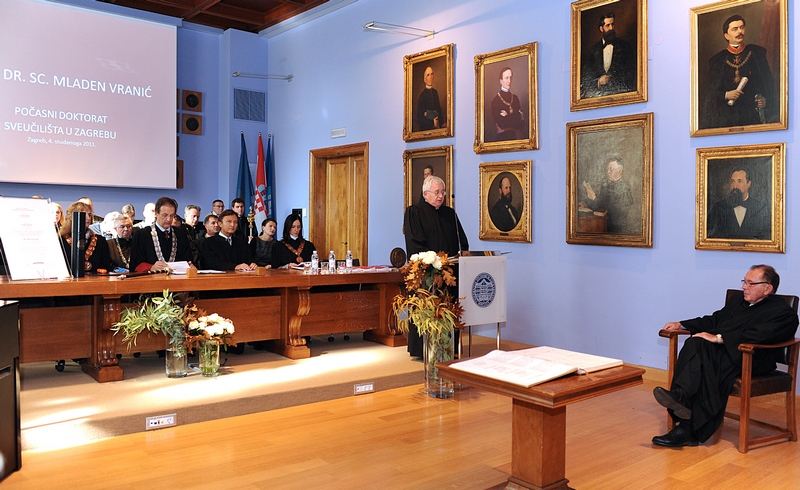

Prof. dr. Željko Metelko, reading his report as promotor of professor Mladen Vranić
| Govor promotora, prof. dr. sc. Željka Metelka, dr. med. Poštovani gospodine rektore, poštovani profesore Vraniću, dame i gospodo! Počašćen sam što mogu, na čelu Povjerenstva formiranoga na temelju odluke Medicinskog fakulteta Sveučilišta u Zagrebu, a koje je predložilo profesora Mladena Vranića, Sveučilište u Torontu, za titulu počasnoga doktora znanosti Sveučilišta u Zagrebu, izložiti neka bitna obilježja njegovih životnih i znanstvenih uspjeha. Mladen Vranić rođen je 1930. u Zagrebu. Studij medicine završio je na Medicinskom fakultetu Sveučilišta u Zagrebu 1955. te je na istom fakultetu, na Katedri za fiziologiju, doktorirao 1962. Danas obnaša dužnost redovitoga profesora fiziologije i interne medicine na Sveučilištu u Torontu, gdje je i član Odjela za endokrinologiju i metabolizam Interne klinike, koledža Senior Scholars te gost profesor Medicinskog fakulteta Sveučilišta u Zagrebu. Profesor Mladen Vranić ima status Fellow, Royal College of Physician and Surgeons of Canada (Medical Scientist) od 1986., Fellow, Royal Society of Canada (Canadian Academy of Arts and Science) od 1997., te status počasnoga doktora u Karolinska Institute Medical Faculty – Stockholm od 1992. Počasni status, profesor Mladen Vranić dobio je na 37 svjetskih sveučilišta, od čega posebno ističem University of Saskatchewan, University of Toronto, Canadian Academy of Health Science, Albert Renold Award of Medical Diabetes Association, Banting Medal and Lectureship of American Diabetes Association, Royal College of Physicians and Surgeons of Canada, Memorijalno predavanje Vuk Vrhovac na Sveučilištu u Zagrebu. Dopisni je član Hrvatske akademije znanosti i umjetnosti, član Svehrvatskog kongresa liječnika i Almae Matris Croaticae Alumni – Toronto. Primio je i najviše kanadske počasti: Order of Ontario, Officer of the Order of Canada, laureat je kanadske medicinske kuće slavnih. Ukupno je 17 znanstvenika sudjelovalo u postdoktorskom radu u laboratoriju profesora Mladena Vranića, bio je mentor 13 doktoranada, 14 magistranada, uz veći broj studenata, od kojih su mnogi danas uvaženi svjetski znanstvenici. Član je 16 stručnih udruženja koja su posebno povezana s dijabetesom i endokrinologijom. Bio je član uredničkog odbora i urednik vodećih časopisa American Journal of Physiology, Canadian Journal of Physiology and Pharmacology i Metabolism. Recenzent je za šest svjetskih časopisa: Diabetes, Endocrinology, Diabetologia, Journal of Clinical Investigation, Metabolism, American Journal of Physiology – Endocrinology and Metabolism i Diabetes Care. Sudjelovao je u 27 različitih nacionalnih i međunarodnih povjerenstava za ocjenu znanstvenih programa. Kao predavač, pozvan je na 157 sveučilišta iz svih krajeva svijeta, uključujući i Zagreb. Uz ostalo, objavio je 214 radova u vrhunskim časopisima, s recenzijom, te 70 poglavlja u knjigama, uključujući i posebne članke; osim toga, urednik je 10 knjiga. Citiran je ukupno više od 8.000 puta. Sadašnji znanstveni interesi profesora Vranića uključuju istraživanje o fiziologiji i patofiziologiji pankreatičnih alfa-stanica u tipu-1 i tipu-2 šećerne bolesti, učinke stresa i tjelovježbe na metabolički sindrom i razvoj tipa-2 šećerne bolesti, uz posebna istraživanja prekomjernoga otpuštanja kortizola u osoba sa šećernom bolešću. Pored toga, sadašnji interes uključuje i učinke stresa i hipoglikemije na odgovor hipotalamičko-hipofizarno-nadbubrežne osovine (ekspresija gena moždanih stres-hormona i njihovih receptora) i kontraregulatornih aktivnosti (kontraregulacijski hormoni, metabolizam glukoze, enzimi srži nadbubrežne žlijezde) u modelima tipa-1 šećerne bolesti. Konačno, jedan od interesa jest i sprječavanje nastajanja hipoglikemije, prema znanstvenom istraživanju smanjivanja manjka glukagona, kortizola i odgovora kateholamina. U ranijim razdobljima znanstveni rad bio je povezan s ulogom jetre i perifernih tkiva, uz poseban interes za inzulinsku rezistenciju i hipertrigliceridemiju. Otkriće ekstrapankreatičnog glukagona, koji je stvoren, ne samo u alfa stanicama gušterače, već i u alfa-stanicama drugih organa, npr. u sluznici želuca psa, otpuštanju glukagona i glukagonu sličnih peptida, pobudio je interes i otvorio cijeli proces razumijevanja stvaranja istoga hormona u različitim organima te novoga oblika liječenja osoba sa šećernom bolešću tipa-2. Njegov pionirski rad o ulozi tjelovježbe u fiziologiji šećerne bolesti omogućio je upoznavanje posebnih metoda u kontroli razine inzulina. Takve studije temelj su spoznaje da osoba s tipom-1 šećerne bolesti, pored tjelovježbe u svakodnevnom životu i radu, može sudjelovati u pojačanoj tjelovježbi, povezano sa sportskim natjecanjima. Prvi je ukazao da tjelovježba dovodi do povećanja otpuštanja inzulina iz mjesta potkožne injekcije. To dovodi do blokade stvaranja glukoze u jetri i mogućeg nastajanja hipoglikemije. Istovremeno, tjelovježba s neodgovarajućim razinama inzulina može dovesti do ekscesivne proizvodnje glukoze u jetri i neodgovarajućega korištenja glukoze u mišićima te do pogoršanja hiperglikemije i regulacije šećerne bolesti. Uz to, profesor Mladen Vranić bio je prvi koji je ukazivao da je međureakcija između inzulina i glukagona glavni regulator stvaranja glukoze u jetri, uz umjerenu tjelovježbu, dok se to isto događa s epinefrinom u intenzivnoj tjelovježbi. Postavio je novu hipotezu o prilagodbi tjelesnih mišića na hiperglikemiju, uz promjenu koncentracije membranskih prenosilaca za glukozu. Postavljena je mogućnost da zbog toga u mišićima ne dolazi do razvoja kasnih dijabetičkih komplikacija. Profesor Mladen Vranić također je istraživao molekularne mehanizme utjecaja kontinuirane tjelovježbe na poboljšanje funkcije pankreatičnih beta-stanica te smanjenje upale kao značajnog znaka pretilosti i šećerne bolesti. Povezanost sa stresom kao predmeta znanstvenog rada, omogućila je dokazivanje da kronični blagi neurogeni stres, koji se događa povremeno, usporava progresiju nastajanja šećerne bolesti. Zaključeno je da stres može na različite načine mijenjati korištenje glukoze, što ima značajnu kliničku implikaciju. Problem stresa i hipotalamičko-hipofizarno nadbubrežne osovine povezan je s intenzivnim inzulinskim liječenjem i pojavljivanjem hipoglikemije. Ako se smanjenjem doze inzulina izbjegne hipoglikemija, pojačava se hiperglikemija s mogućim efektom nastajanja dijabetičkih komplikacija. Odgovor u tijelu na hipoglikemiju počinje neodgovarajućom regulacijom gena za ekspresiju mineralokortikoida i glukokortikoidnih receptora u hipokampusu cns-a, paraventrikularnim jezgrama i hipofizi. Manjak reakcije epinefrina na hipoglikemiju, mogla bi biti posljedica smanjene ekspresije gena za kontrolu adrenomedularnih enzima potrebnih za sintezu. Uloga jetre u problemu nastajanja inzulinske rezistencije, kao i hipertrigliceridemije, bila je predmet istraživanja profesora Mladena Vranića u ranijim razdobljima njegova znanstvenog rada. Provođenje kliničkih studija o inzulinskoj rezistenciji, hipertrigliceridemiji, omogućilo je prve radove u tom području. Iz tih istraživanja objavio je postavke kako mišići, jetra i pankreatične alfa-stanice reagiraju i prilagođavaju se na hiperglikemiju, povećavaju ciklus metabolizma glukoze u jetri i suprimiraju odgovor glukagona na hipoglikemiju iz gušterače. Unatoč iznimnim znanstvenim aktivnostima u Kanadi, kao i na različitim sveučilištima u svijetu, profesor Mladen Vranić nikada nije prekinuo suradnju s Hrvatskom. Godine 1977. nagrađen je diplomom Sveučilišne klinike Vuk Vrhovac, kada je održao nadahnuto predavanje o problemima tjelovježbe i daljnjih istraživanja u području šećerne bolesti. Od 1995. član je izdavačkog povjerenstva časopisa Croatian Medical Journal. Od 2004. član je Savjetodavnog povjerenstva Medicinskog fakulteta Sveučilišta u Zagrebu za potrebe medicinskih studija na engleskom jeziku. Od 2005. počasni je predsjednik Almae Matris Croaticae Alumni (za područje Toronto, Ontario). Gotovo svake godine, profesor Mladen Vranić sudjeluje u različitim znanstvenim skupovima u Hrvatskoj, posebno iz područja dijabetologije i endokrinologije, te pridonosi edukaciji mladih istraživača u Hrvatskoj. Profesore Mladene Vraniću, Vaša istraživanja o fiziologiji i patofiziologiji pankreatičnih alfa-stanica u tipu-1 i tipu-2 šećerne bolesti, kao i otkriće bjelančevina sličnih glukagonu u sluznici želuca pasa, otvorili su potpuno novo poglavlje u liječenju šećerne bolesti. Ispitivanje stresa i tjelovježbe na metaboličke procese u tijelu, omogućilo je razumijevanje i međuodnose inzulina, posljedične hiperglikemije, analize kontrainzularne osovine hipotalamus-hipofiza-nadbubrežne žlijezde te je otvorilo prostor za odgovarajuće reakcije u stanjima hipo i hiperglikemije. Konačno, Vaši radovi o kvantifikaciji čimbenika uključenih u patogenezu šećerne bolesti, analize metabolizma glukoze u jetri kao i trigliceridemije, objasnili su dio nastajanja procesa inzulinske rezistencije. Na temelju sažetoga prikaza iznimnoga znanstvenog i nastavnog opusa profesora Mladena Vranića, i njegovim utjecajem na razvoj istraživanja, ali i liječenje šećerne bolesti, što je prepoznato u cijelome svijetu, smatram da je za Sveučilište u Zagrebu velika čast dodijeliti ovaj počasni doktorat. |






Professor Mladen Vranić decorated with nice interlace patterns from old Croatian stone monuments dating from 9th and 10th centuries.


Rector Aleksa Bjeliš and professor Mladen Vranić

Professors Mladen Vranić and Zvonimir Šeparović
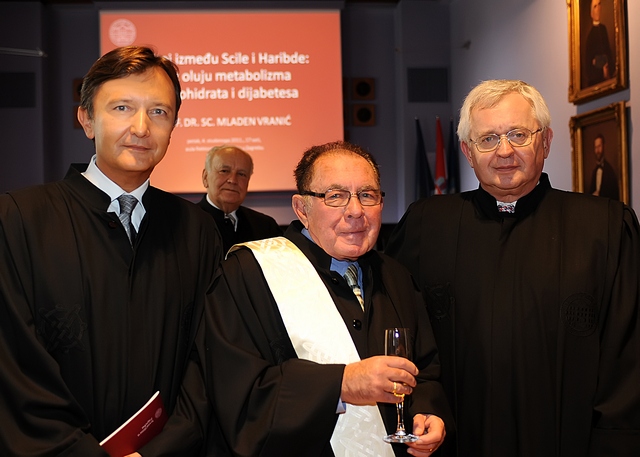
Professors Davor Miličić, Mladen Vranić and Željko Metelko

Professors Davor Miličić, Mladen Vranić and Željko Metelko
| Professor Mladen Vranić I would like to thank Rector, Bjelis, and professor Metelko for presenting me in such a marvelous way. I would also like to thank the Faculty of Medicine for nominating me, and to the senate for confirming this recognition. I would like to give special thanks to the former Dean, Nada Cikes, and Davor Jezek for their continuing support in many of my activities at the University of Zagreb. There is no greater honour than receiving an honourary degree from my Alma Mater, the University of Zagreb, which has had a strong tradition in teaching and research for more than 200 years. I also feel particularly touched to be included amongst the group of 93 leaders in Arts and Science who have received this award. All of these recognitions stimulate further research, and I hope that my own work confirms your confidence.  Figure 1 I was born in Zagreb in 1930 to Vladimir and Ana (Figure 1), and I grew up as an only child in an environment strongly influenced by the academic pursuits of my father, who was a mathematician. Our home was a gathering place, not only for colleagues of Science, but also for colleagues in the Arts, including actors and musicians. For a young person, it was a wonderful experience and unique to the culture of Zagreb at the time. Even my elementary school was influential, preparing us to fight for originality and for useful stubbornness. In 1918, my father and his brother changed their name and religion, in order to facilitate joining mainstream life in Croatia. My father completed a doctorate in mathematics and physics and became a private docent. He was considered a very talented scientist, but because of his background, he was told that he would not be able to pursue and academic career. My father became Vice President of an Italian insurance company, but he was also well known in the University Community and continued to give lectures, examinations, and write mathematical books and scientific papers. However, in May 1941, he received a letter from the Rector of the University in Zagreb, which explained that his appointment was being terminated to adhere to the racial laws. The letter stated that he did an important job for the University without any enumeration. 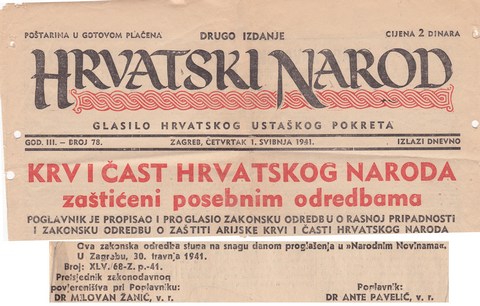 Figure 2 When I was 10 years old, I came home and told my parents that we played an interesting game at school: “Chase the Jews”. This is when my parents explained to me that I was of Jewish background. At the time, this didn’t have any effect on me because I felt that I was never exposed to any anti-Semitism, and our school game reflected more of a harmless game of tag. However, when the Ustase ruled in Croatia, I noticed that there were strange pictures in the newspapers. My father saved those newspapers, and the titles were telling. “Blood and Dignity of the Croatian People are Protected by Special Provisions”, signed by Milovan Zanic and Ante Pavelic (Figure 2). I didn’t yet understand that this was a death sentence for my family and me. In the same newspapers, on May 3, 1941, there was also an article that explained the genetic need for the new racial laws, written by a professor of genetics. 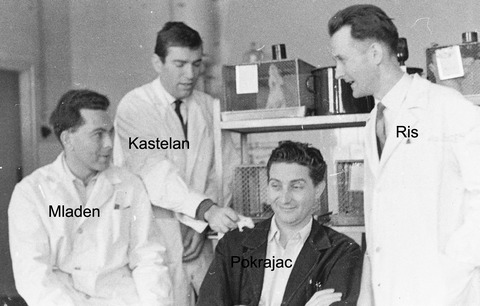 Figure 3 My first year of high school coincided with the fascist Ustase government in Croatia. With my father, mother, and grandmother, I managed to escape in 1941 to Crikvenica, which was under Italian occupation. Sadly, however, most of my other relatives were killed in the extermination camps of the Ustase or the Nazis. In 1942, we spent one year in Italian concentration camps at Kraljevica and Rab, respectively. The prisoners organized a school in the camp, and some of the teachers in these concentration camps actually became University Professors in Zagreb after the war. Following the collapse of Mussolini's government in Italy in 1943, and because a large part of Croatia was liberated by the Partisans, we were able to escape in January 1944 from the island of Rab to Taranto (Italy), which at that time was occupied by the Allied forces. Our escape was made possible when the last partisan ship carrying wounded partisans also carried us to the island of Vis. For the last year of the war, my father returned to Croatia to join the Partisan movement, while I, my mother and my grandmother stayed in Taranto until the end of the war. 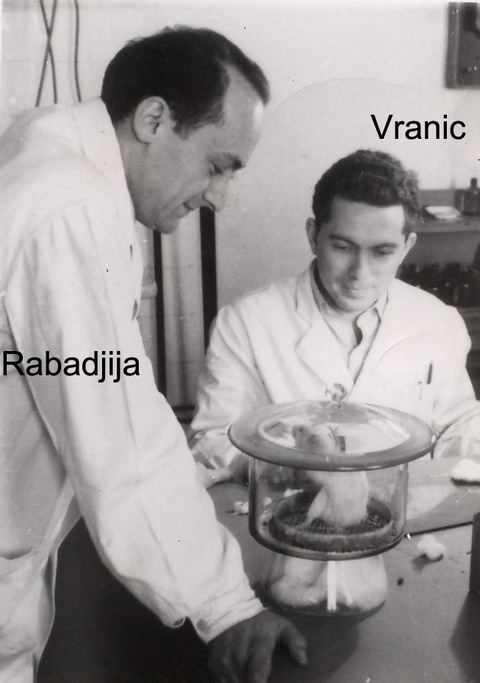 Figure 4 I spent two years of high school in Taranto, and since the education focused mainly on classics, it greatly stimulated my love for literature. We covered, Dante’s Comedia Divina, and I knew a lot of it by heart. Today I only remember Francesca De Rimini’s statement “Amor Cha Nullo Amato Amar Perdona”. I was much luckier than Francesca since I am very fortunate to have a fantastic wife, whose support has always been invaluable, and three daughters, who are great fun. After the war, I returned to Zagreb and completed my final three years of high school. In the meantime, my father became professor and Dean of Economics and later Engineering, and he also lectured on the theory of probability. In addition, my father also brought the first computer to the University of Zagreb, despite the fact that his mathematical colleagues thought that using a computer would be a “prostitution” of math. 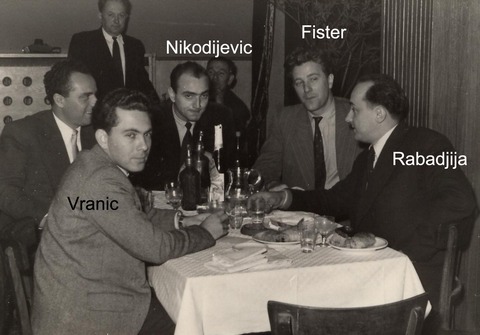 Figure 5 I enrolled in the Medical School in Zagreb, where the Department of Physiology had a keen scientific interest in carbohydrate metabolism and diabetes, initiated by Professor Allegretti a few years earlier. This early summer, scientific experience in Zagreb was further enhanced by my participation in two summer research programmes at the Universities of Vienna and Amsterdam. The only experience I had as a practicing physician was during internship and one year of military service, and since it would have been very difficult to combine clinical practice with basic research, I decided to embark on a career as a physiologist. During summers and later, as a research assistant, a close collaboration developed with Drs. Allegretti (Chairman of the Department), Pokrajac, Rabadija and Mihic. In addition, we had intense discussions with respect to teaching and research with Fister, Gabric, Ris, Nakic, Kastelan, and Silobrcic (Figures 3, 4, 5). The intense teaching of general physiology provided a background for the rest of my career, and it was a critical early experience.  Figure 6 My Ph.D. thesis discussed the growth of pancreatic islets by cortisol, providing early evidence that new islet cells sprout from ducts. I presented this work when I arrived in Toronto, and my post-doctoral supervisor (the co-discoverer of insulin, Dr. Charles Best), was extremely enthusiastic, which was of great importance for my initial career. It was marvelous how Professor Best stimulated young researchers.  Figure 7 When completing my Ph.D thesis, I felt that I needed post-doctoral training, and a well-known German professor of Diabetology, Werner Creutzfeld, whose father co-discovered “mad-cow disease”, helped me many years earlier. He introduced me to Otto and Anna Sirek, from the University of Toronto, and after exchanging a few dramatic letters, Dr. Best invited me to be his last post-doctoral Fellow (Figures 6, 7). I got a passport from the Ministry of Anterior, who felt that my late-wife, Magda, and two-year old daughter Iva, would have to remain behind. Fortunately, my mother had a spa in Zagreb, and one of her patrons was Savka Dabevic. Luckily Savka supported us, and so my Canadian adventure started.  Figure 8 In Toronto, I got very interested in sophisticated research in the field of Diabetes and I felt that in order to continue, it would be advantageous to stay in Canada, at least for a while. Savka was disappointed, but when she later experienced her own troubles, she understood my decision much better. Three years after arriving in Canada, we returned to Zagreb for a visit. It was an incredibly emotional moment. I realized that when I was living in Croatia, I took for granted the beauty of its cities, Dalmatian coast, and its mountains. My love was for the incomparable rock-climbing in Slovenia. When visiting Croatia, there was some resentment from my colleagues because I had left the country. However, from the beginning, I had a close relationship to the Vuk Vrhovac Institute of Diabetes, which can be credited to Professor Skrabalo (Figure 8). This resulted in collaboration, regular visits to Zagreb, and participation at many symposia; some of which we organized together. I was also well supported by Granic, later by Metelko, and other diabetologists throughout Croatia. My relationship to the University of Zagreb has always remained important, and this has resulted in many collaborations and long lasting friendships. I was very honoured to be one of the first three Croatian Scientists, who became visiting professors. In 1989, we organized an international meeting between Zagreb, Toronto, Stockholm, and Boston, where in addition to all Croatian diabetologists, we also had Dr. Luft, Chair of the Nobel Committee, its secretary, and a number of additional scientists. From 1991 to 1993 I organized visits from the Rector, and many professors from the University of Zagreb, which was helpful to inform the Canadian public about the situation in Croatia (during Domovinski Rat). I was especially honoured when I became a corresponding member of the Croatian Academy of Arts and Science. I was very honoured when I received a diploma for the promotion of Croatian medicine and public health from the Croatian Medical Council. Dr. Janko Herak included aspects of my life and science in the book Distinguished Croatian Scientists in the World. I have given many lectures throughout Croatia, and I am a member of the International Committee for Medical Studies in English, in Zagreb. For many years I have promoted the relationship between the Universities of Toronto and Zagreb. This coincided with my title as Honourary President of Toronto AMCA. In terms of my research, I participated in a number of areas in Diabetes research, which developed sequentially, like a story. To understand pathology of Diabetes, it is necessary to measure production of glucose, mainly by the liver, and utilization of glucose, mainly by the muscle, even when the sugar dramatically changes in blood. I was lucky that there were two students who had a background in biophysics. This allowed us to further develop such methods, which were previously not used in clinical research. We modified the methods, validated them, and like a tsunami, clinical and basic researchers started to use those methods widely. This provided the basis for understanding the role of different hormones and their interactions, and how they work in physiology and in Diabetes. The breakthrough occurred when I was invited by the Kroc Foundation in California to organize the first Symposium on Exercise and Diabetes. In a fantastic environment, a group of 25 scientists intensified work in this field, which was followed by a number of symposia. Today we know that exercise cannot only improve diabetes, but it can also prevent the onset of type 2 diabetes. There was a dramatic improvement for diabetics after we and others classified the problems related to exercise and diabetes, so that today, even diabetic patients can become Olympians. With clinical researchers, we also classified the effects of some lipid diseases. However, the question still remained; why could exercise prevent diabetes? Most recently, in a series of papers, we hypothesize that exercise affects the hypothalamic-pituitary-adrenal axis and the release of cortisol. It increases glucose utilization by the muscle, and decreases inflammation. All of these factors decrease oxidative stress, and protect the islet cells in the pancreas from deteriorating. This work combines tracer, biochemical, and molecular methods, and it was only possible through wide collaboration with specialists in different areas. In addition, we now know that repeated stress can deteriorate diabetes and perhaps even induce diabetes. Very much to our surprise and to that of clinicians, we showed that if animals can adapt to repetitive stress, they could actually prevent the onset of diabetes, as is the case with exercise. This concept of adaptation to stress carries implications for many diseases. Diabetes is such a dangerous disease, because it can affect many organs. This is because increased blood-sugar enters the cells and affects the structure of many proteins. We demonstrated a mechanism, whereby both the liver and the muscle are protected against high blood sugar, and thus, they are also protected against major complications. The general belief concerning the endocrinology of the pancreas was that insulin and glucagon (its two main hormones) were only produced in the pancreas. In experiments that we conducted both in Toronto and during my sabbatical in Geneva, we demonstrated in dogs, that the stomach can produce equal amounts of glucagon as the pancreas. This was a very dramatic finding, because it changed a scientific dogma. It not only explained the role of glucagon in diabetes, but it was also very helpful in understanding the interrelationships of the effects of insulin and glucagon. In the last twenty years, it became clear that improved blood sugar control decreases the danger of diabetic complications. This is called, intensive insulin treatment. However, the problem is that this results more frequently in episodes of low blood sugar, which complicates a diabetic’s life. It can be lethal and damage the brain, since this is dependent on a normal supply of blood sugar. We studied why low blood sugar occurs using molecular methods to study changes of genetic activities in the brain, and we patented a new method to prevent low blood sugar. The experiments are still being conducted in rats until every aspect is sufficiently safe to start experimenting in humans. In terms of my successes, my greatest pleasure and pride has been that some of my graduate students and post-docs are leaders in their own fields today. For example, they have been Presidents of the American Diabetes Association, Japanese Diabetes Association, and the European Association for Studying Diabetes. In addition to my own research and teaching, I have been involved in administrative work as a Chair, or as a member of various committees organizing symposia. I am proud that during my Chairmanship of the Department of Physiology, I brought together clinicians and basic scientists for collaboration. I have also worked for many granting agencies and journals as an Associate Editor. I am extremely proud for being a member of four academies, having four honourary degrees, receiving the two highest Canadian Civilian Awards, and for being the only Canadian who has received Key recognitions in Diabetes, with respect to science and training of future scientists. The great American Poet Robert Frost wrote in his famous piece “The Road Not Taken” captured what I have seen so many successful people do. He writes:- I shall be telling this with a sigh Somewhere ages and ages hence: Two roads diverged in a wood, and I – I took the one less traveled by, And that has made all the difference. Indeed, all of us are always facing major choices. I attempted to take the road “less traveled”. That is the route to originality, which in my opinion is the key to making a difference in any discipline or any profession. Life can be unfair and it can be tough. It is not easy, to get new and original ideas accepted, and it is a constant fight to get grants, and to get papers and new ideas accepted in competitive journals. In that respect, I titled a recent retrospective “Odyssey between Scylla and Charybdis through storms of carbohydrate metabolism and diabetes”. You may recall that Scylla and Charybdis were two sea monsters in Greek mythology described by Homer. They were located close enough to each other that they posed an inescapable threat to passing sailors, including Odysseus. Avoiding Charybdis meant passing too close to Scylla and vice versa. 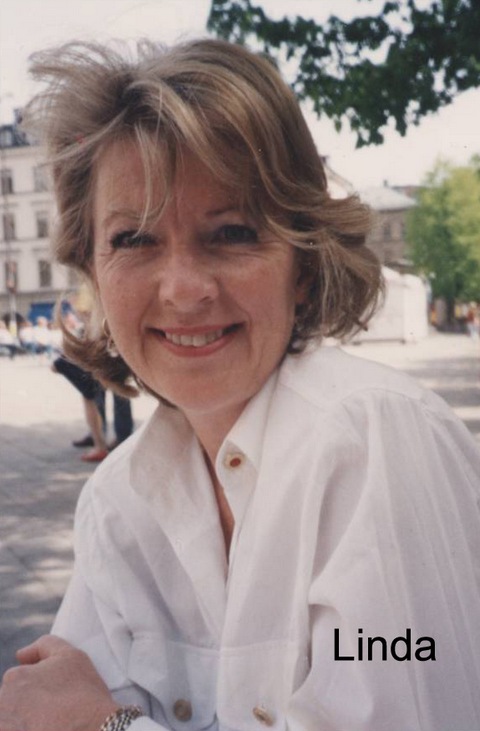 Figure 9 Life is full of such challenges. It may sometimes feel as if you need the legendary strength and perseverance of Odysseus to avoid being devoured by sea monsters. But you can and must persevere.  Figure 10 In the end, my thanks go to my wife Linda (Figure 9), since without her love and support, it would be impossible to get through all of life’s challenges and the stresses of immigration. My daughters, Iva, Anne, and Claire (Figure 10) are all very successful in their own endeavors, but in my dreams, I still see them as little girls who have enchanted me with their fun. |

Professor Mladen Vranić with his colleagues from the Univeristy of Zagreb,
in front of the bronze monument "History of the Croats" (Povjest Hrvata) by Ivan Meštrović.
Many thanks to Ms Sandra Kramar, University of Zagreb, for the photos.
in front of the bronze monument "History of the Croats" (Povjest Hrvata) by Ivan Meštrović.
Many thanks to Ms Sandra Kramar, University of Zagreb, for the photos.
Formated for CROWN by prof.dr. Darko Žubrinić
Distributed by www.Croatia.org . This message is intended for Croatian Associations/Institutions and their Friends in Croatia and in the World. The opinions/articles expressed on this list do not reflect personal opinions of the moderator. If the reader of this message is not the intended recipient, please delete or destroy all copies of this communication and please, let us know!
Distributed by www.Croatia.org . This message is intended for Croatian Associations/Institutions and their Friends in Croatia and in the World. The opinions/articles expressed on this list do not reflect personal opinions of the moderator. If the reader of this message is not the intended recipient, please delete or destroy all copies of this communication and please, let us know!